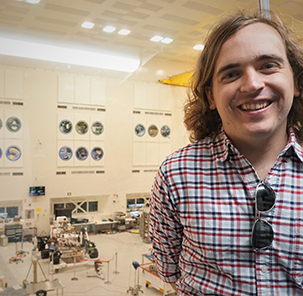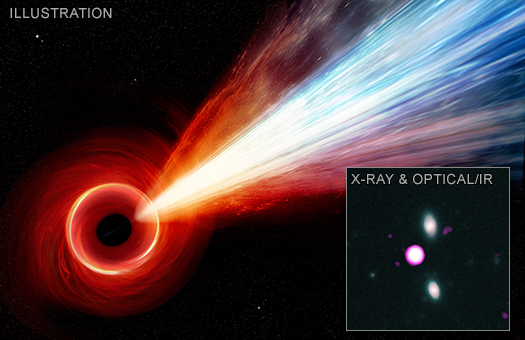From NASA’s Jet Propulsion Laboratory to the Universe's Earliest Jet propulsion Laboratory
We are happy to welcome Thomas Connor as a guest blogger today. Thomas is a NASA Postdoctoral Fellow at NASA Jet Propulsion Laboratory (JPL) in Pasadena, California and the author of a paper that is the subject of our most recent press release. He completed his undergraduate degree at Case Western Reserve University and earned his doctorate from Michigan State University. Prior to starting at JPL, Dr. Connor was a postdoctoral fellow at the Observatories of the Carnegie Institution for Science. His scientific interests include black holes in the dawn of the Universe, the evolution of galaxies in dense environments, and the structure of the Cosmic Web.
Most of the fundamental questions of astronomy relate to how the universe as we observe it was assembled. From stars and planets to nebulae and galaxies, many of the investigations of astronomy come down to crafting a coherent narrative of formation and evolution. Currently, that narrative is struggling to be built in the early universe, where supermassive black holes with masses a billion times that of the Sun are seen only a few hundred million years after the Big Bang. The challenge here is that, while we can model ways for such massive objects to form and grow, compressing that growth into such a short time scale is much more difficult. As an analogy, it is not surprising that an author can write a novel, but it would be astounding if she could do so in only one day.
Black holes grow by eating their surroundings, but, contrary to the typical depiction of these objects, they do not suck. Rather, they slowly nibble their way through an "accretion disk," an orbiting disk of gas that acts as a buffet for the black hole. As more gas makes its way inward, this disk will get hot from all of the friction of particles rubbing together, and it will start glowing like a hot coal. This bright light will act like a strong wind, pushing away further gas from replenishing the disk. Thus, the black hole's feeding is self-limiting — if it eats too fast, it won't be able to restock the buffet, and so it will have to slow down. This fundamental limit is why we are puzzled at how such massive black holes can exist so early.
One potential way around this quandary is for a magnetic field to be slowly taking energy from the disk and using that energy to shoot a beam of particles traveling at speeds approaching that of the speed of light. For a gas particle orbiting in the disk, its orbital speed is the only thing preventing it from becoming dinner; losing even a little of that speed to this magnetic braking will cause more particles to fall into the black hole, thereby increasing the rate of feeding. And the beam of very fast moving particles — called a "jet" — is very narrow, like a pencil. Thus, unlike the glowing disk, which pushes out everything around it, these jets only affect a very small amount of the infalling material and therefore don't slow the replenishment of the cosmic buffet. Jets are seen in the local Universe (defined here as things within a few billion light years of the Earth), but are not commonly seen in the first billion years of the Universe. Evidence of massive jets in this era could therefore be indicative that black holes have found ways around this feeding limit paradox.
This is where my work comes in. I used NASA's Chandra X-ray Observatory to identify the X-ray signatures of a jet stretching over 100,000 light years from a black hole seen less than a billion years after the Big Bang. The fast-moving particles in this jet emit X-rays when they interact with the residual glow of the Universe's formation, which is even stronger the closer we look to the Big Bang. Previously, people have argued that this X-ray emission should be the dominant signature of early Universe jets, but confirmation of this effect has been difficult to gather.
My work focused on a single supermassive black hole — called a quasar, when we talk about the light we see from its surroundings — called PSO J352.4034—15.3373, or P352 for short. Radio observations showed that this black hole has a jet, but the jet was only seen to extend on scales of a few thousand light years. With Chandra, we were able to see that this jet actually extends over ten times farther than we previously thought. Not only does this imply the black hole could use the jet to increase its feeding rate for at least ten times as long (because for something travelling at a fixed speed, length is equivalent to time), but it supports the idea that X-ray astronomy is necessary to understand the early growth of black holes.
Illustration and X-ray, optical, and infrared Image of PSO J352.4034—15.3373 (Credit: X-ray: NASA/CXO/JPL/T. Connor; Optical: Gemini/NOIRLab/NSF/AURA; Infrared: W.M. Keck Observatory; Illustration: NASA/CXC/M.Weiss)
On a personal level, the work involved in analyzing these observations was a roller coaster of excitements and disappointments. When I first looked at these images, I was expecting to see a thin straight line, as is seen for jets from black holes closer to us. The disappointment of not seeing that led to excitement when I realized there was a glowing knot in the direction where we expected to see evidence of a jet. I was even more excited when I was able to use two of the best telescopes on Earth — one each of the twin Gemini and Keck telescopes — to confirm that this knot was a real detection. Sadly, the new data actually showed my original hopes were wrong, and that the X-ray blob I first looked at was actually just an unrelated object. But then my excitement returned when a statistical analysis showed there was a different X-ray signature from the jet that was not ruled out by my new data. I think almost every professional astronomer has a story about a big discovery that ended up fizzling out, whether due to obtaining further observations or even just debugging a code; but spending effort trying to prove yourself wrong makes those times when your results hold up that much sweeter.
Luckily, this work is just beginning. P352 was only discovered in 2018, and, since then, multiple new black holes have been discovered at even earlier times in the Universe that could also potentially host jets. Earlier this month, the same team that was involved in this work announced the discovery of a black hole seen 200 million years closer to the Big Bang! Chandra will continue to play a pivotal role as we try to discover ways for these early black holes to grow as quickly as they did.
Category:
- Log in to post comments


